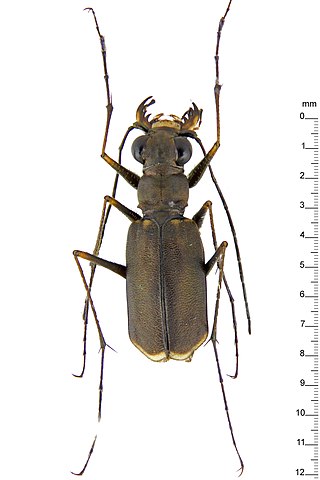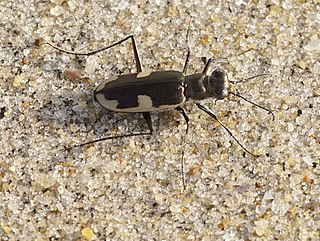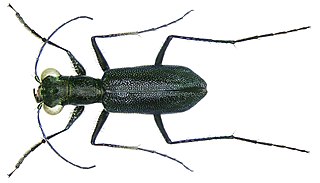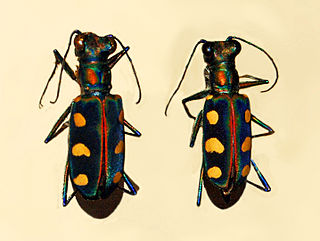
Tiger beetles are a family of beetles, Cicindelidae, known for their aggressive predatory habits and running speed. The fastest known species of tiger beetle, Rivacindela hudsoni, can run at a speed of 9 km/h, or about 125 body lengths per second. As of 2005, about 2,600 species and subspecies were known, with the richest diversity in the Oriental (Indo-Malayan) region, followed by the Neotropics. While historically treated as a subfamily of ground beetles (Carabidae) under the name Cicindelinae, several studies since 2020 indicated that they should be treated as a family, the Cicindelidae, which are a sister group to Carabidae within the Adephaga.

Cicindela, commonly known as common tiger beetles, are generally brightly colored and metallic beetles, often with some sort of patterning of ivory or cream-colored markings. They are most abundant and diverse in habitats very often near bodies of water with sandy or occasionally clay soils; they can be found along rivers, sea and lake shores, sand dunes, around dry lakebeds, on clay banks, or woodland paths.

The wildlife of Malaysia is diverse, with Malaysia being a megadiverse country. Most of the country is covered in rainforest, which hosts a huge diversity of plant and animal species. There are approximately 361 mammal species, 694 bird species, 250 reptile species, and 150 frog species found in Malaysia. Its large marine territory also holds a great diversity of life, with the country's coastal waters comprising part of the Coral Triangle.
Caledonomorpha is a genus in the tiger beetle family Cicindelidae.

Callytron is a genus in the beetle family Cicindelidae. There are about 11 described species in Callytron.

Collyris is a genus in the beetle family Cicindelidae. There are about 10 described species in Collyris.
Cratohaerea is a genus of tiger beetles. There are at least three described species in Cratohaerea, found in Africa.

Derocrania is a genus of tiger beetles. There are about 16 described species in Derocrania, found in India and Sri Lanka.
Dilatotarsa is a genus of tiger beetles. There are about eight described species in Dilatotarsa, found in the Pacific islands of Southeast Asia.
Euryarthron is a genus in the beetle family Cicindelidae. There are more than 20 described species in Euryarthron, found in Africa.
Heptodonta is a genus in the beetle family Cicindelidae. There are about 15 described species in Heptodonta.

Hypaetha is a genus in the beetle family Cicindelidae. There are about 14 described species in Hypaetha.

Jansenia is a genus in the beetle family Cicindelidae. There are at least 40 species in the genus, all of which are found only in South Asian region, with several endemic to India and Sri Lanka. The genus is characterized on the basis of the male genitalia.

Polyrhanis is a genus in the beetle family Cicindelidae. There are more than 50 described species in Polyrhanis.

Prothyma is a genus in the beetle family Cicindelidae. There are more than 40 described species in Prothyma.

Protocollyris is a genus of tiger beetles in the family Cicindelidae, tribe Collyridini.

Therates is a genus of tiger beetles found in South and Southeast Asia. A study of two species in the Philippines suggests that females tend to be larger with wider elytra width.
Celaenephes is a genus in the ground beetle family Carabidae.

Cicindela aurulenta, common name blue-spotted or golden-spotted tiger beetle, is a beetle of the family Cicindelidae.

Cicindelini is a tribe of tiger beetles in the family Cicindelidae, containing the overwhelming majority of genera and species in the family. There are more than 90 genera and 2,000 described species in Cicindelini.














